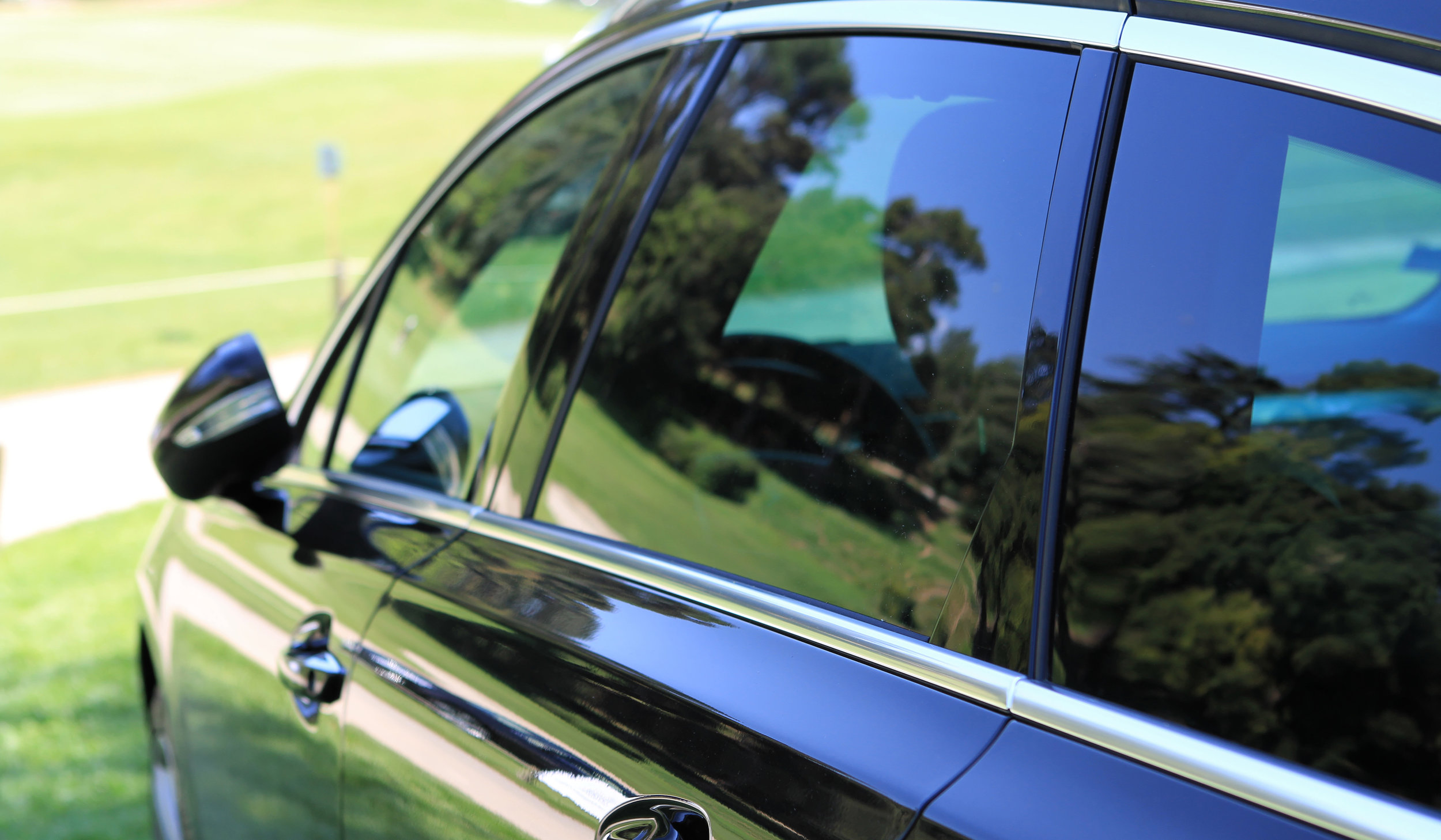How Dark Is 35 Window Tint

Introduction
How Dark Is 35 Window Tint: Window tint darkness is typically measured using the Visible Light Transmission (VLT) percentage, which indicates the amount of visible light that can pass through the tinted windows. A 35% window tint, therefore, allows 35% of visible light to pass through the film while blocking the remaining 65%. A 35% window tint is considered moderately dark. It allows a significant amount of visible light to enter the vehicle or space while still providing privacy and some sun protection. The darkness level strikes a balance between aesthetics, visibility, and functionality.
While not as effective as darker tints in reducing heat and glare, a 35% tint can still provide noticeable improvements in comfort by blocking a portion of the sun’s heat and reducing glare from sunlight and headlights. A 35% tint provides decent UV (ultraviolet) protection by blocking a portion of harmful UV rays. This protection can help safeguard your skin and prevent interior fading and damage to furniture or upholstery. Many people choose a 35% tint for its aesthetic appeal. It can enhance the look of a vehicle or property, giving it a sleek and stylish appearance without making the tint windows appear overly dark.
The permissibility of a 35% window tint can vary depending on your location. It’s crucial to check local regulations and laws regarding window tint darkness levels, as these regulations differ from place to place. In some regions, a 35% tint may be within legal limits for all windows, while in others, it might only be allowed on specific windows, such as the rear side windows and rear windshield.
Is 35 a good window tint?
If your primary motivation in choosing a tint for your windows is to reduce eye strain, glare or UV rays, then you don’t need to go darkest legal to reap the benefits of good quality window tint. A 35% film is a good option for making driving more comfortable and prolonging the life of your car’s interior.
Moderate Darkness: A 35% tint is moderately dark, offering a balance between aesthetics and functionality. It provides privacy without making the windows excessively dark.
Heat Reduction: While not as effective as darker tints, a 35% tint can still reduce the amount of heat that enters your vehicle or space, making it more comfortable in hot weather.
Glare Reduction: It helps reduce glare from the sun and headlights, enhancing visibility and reducing eyestrain, especially during daytime driving.
UV Protection: A 35% tint offers decent UV (ultraviolet) protection by blocking a portion of harmful UV rays, which can help protect your skin and prevent interior fading.
Aesthetics: Many people choose a 35% tint for its aesthetic appeal, as it enhances the appearance of vehicles or buildings without making the windows appear overly dark.
Is 35% tint too light?
35% is fine for visibility at night as well. Darker tint has gone out of style but with anything it’s personal preference. I wouldn’t tint too dark if it’s a leased car either, as you may run into issues when returning.
Local Regulations: Check your local regulations regarding allowable window tint darkness levels. In some areas, a 35% tint may be within legal limits for all windows, while in others, it might only be allowed on specific windows, such as the rear side windows and rear windshield.
Nighttime Visibility: A 35% tint is moderately dark and generally should not significantly impact nighttime visibility. However, it’s essential to consider your comfort and visibility preferences when driving at night.
Climate: The effectiveness of a 35% tint can vary depending on your location and climate. In regions with extremely hot and sunny weather, you might benefit from a darker tint for better heat reduction.
Privacy: Assess your privacy needs. A 35% tint offers a degree of privacy but may not completely conceal the interior of your vehicle or property, which could be a consideration depending on your specific situation.
Is 50% darker than 35%?
Because less light can get through, the window tint with 35% VLT will look darker than the 50% VLT. If you want to upgrade your ride with dark, sleek windows, make sure you choose a low VLT percentage.
No, 50% is not darker than 35% when it comes to window tint darkness levels. In the context of window tinting, the percentage refers to the Visible Light Transmission (VLT) percentage, which indicates the amount of visible light that can pass through the tinted windows.
Here’s how these two percentages compare:
35% Window Tint: A 35% tint allows 35% of visible light to pass through and blocks the remaining 65%. It is considered moderately dark, offering a balance between aesthetics and functionality.
50% Window Tint: A 50% tint allows 50% of visible light to pass through and blocks the remaining 50%. It is lighter and allows more light to enter compared to a 35% tint.
Is 35% tint legal in UK?
United Kingdom has very clearly defined laws for window tint. Front windshield and front side windows may have up to 75% and 70% light transmission respectively, and all windows to the back of the driver can have any tint darkness levels.
Front Windscreen: The front windscreen (front windshield) must allow at least 75% of light to pass through, meaning it must have a VLT (Visible Light Transmission) of 75% or more. In practical terms, this means that you cannot apply any tint to the front windscreen.
Front Side Windows: The regulations for front side windows (the driver’s and passenger’s windows) vary depending on when the vehicle was first used:
Vehicles First Used Before April 1, 1985: There are no specific regulations for front side windows on older vehicles.
Vehicles First Used On or After April 1, 1985: Front side windows must have a minimum VLT of 70%.
Rear Side Windows and Rear Windscreen: There are no specific regulations regarding the darkness of tint applied to rear side windows and the rear windscreen. However, it is recommended to use a tint that allows good visibility to ensure safe driving and compliance with other road rules.
Is 35% tint dark enough?
A vehicle with a 35% tint will give you a darker, more appearance but is still very easy to see through. Many people like this tint because it creates a smooth, stylish look. If you’re concerned about privacy, you may want a 20% tint. Although you can see through it from the outside if you’re up close, it’s difficult.
Check local regulations regarding allowable window tint darkness levels. Ensure that a 35% tint complies with these regulations to avoid legal issues and penalties.
A 35% tint is moderately dark and generally should not significantly impact nighttime visibility. However, consider your comfort and visibility preferences when driving at night.
Assess your privacy needs. While a 35% tint provides some privacy, it may not completely conceal the interior of your vehicle or property. If privacy is a primary concern, you may opt for a darker tint.
The effectiveness of a 35% tint in heat reduction can vary depending on your location and climate. In extremely hot and sunny regions, you might benefit from a darker tint for better heat control.
What is the best tint for night driving?
Ceramic tints are the best option for maintaining good visibility at night, as they do not reduce the amount of light entering the car, nor do they cause reflections or distortions that impair vision.
No Tint or Clear Tint: For the best visibility at night, it’s recommended to avoid window tint or choose a clear or nearly clear window film that provides minimal darkening. This allows the maximum amount of light to enter your vehicle.
Legal Compliance: Check your local regulations regarding allowable window tint darkness levels, especially for front side windows and the front windshield. Many regions have specific restrictions on tint darkness for these windows, often requiring them to be untinted or very lightly tinted.
Safety and Visibility: Driving at night already presents challenges due to reduced natural light. Tinted windows, especially darker tints, can exacerbate these challenges by further reducing visibility. It’s essential to prioritize safety and ensure you have a clear view of the road, traffic signals, and other vehicles.
Interior Lighting: Consider using interior lighting in your vehicle, such as dashboard lights and cabin lights, to maintain visibility of the vehicle’s interior while keeping the windows clear for optimal external visibility.
What percent tint looks best?
If you’re looking for a stylish and smooth look for your mobile car, the best window tint percentage is 35%. It gives off a darker appearance without sacrificing visibility.
Light Tint (70% to 90% VLT): Light tint levels, such as 70% or 90%, provide a subtle, barely noticeable tint. They offer some UV protection and a minor reduction in heat and glare. These tints are often chosen for a minimal and unobtrusive appearance.
Moderate Tint (35% to 50% VLT): Tints in the range of 35% to 50% VLT are considered moderately dark. They strike a balance between aesthetics and functionality, providing privacy, heat reduction, and glare reduction while maintaining good visibility.
Darker Tint (20% to 30% VLT): Darker tints in the 20% to 30% VLT range provide more privacy and greater heat and glare reduction. They are often chosen for their sleek appearance and enhanced comfort.
Limo Tint (5% to 15% VLT): Limo tint levels are the darkest and provide maximum privacy, heat reduction, and glare reduction. However, they significantly reduce visibility, especially at night. Limo tint is typically used for style and privacy rather than practicality.
What is the best tint for front windshield?
Experts recommend IR or infrared rejection ceramic tints for windshields. These provide essentially 80 percent VLT or visible light transmission. The visible light transmission percentage refers to the amount of visible light that penetrates a surface, such as glass or tint film.
Legal Compliance: First and foremost, you must adhere to local laws and regulations regarding front windshield tint. Most areas restrict or prohibit any tint on the front windshield, as it can significantly reduce visibility, especially at night.
Safety and Visibility: The front windshield is crucial for a clear view of the road, traffic signals, pedestrians, and other vehicles. Even a light tint can interfere with visibility, particularly under low-light conditions. Safety should always be the top priority.
UV Protection: If you’re concerned about UV protection and heat reduction for the front windshield, consider using a clear or nearly clear UV-blocking film. These films are designed to provide UV protection without significantly darkening the glass.
Professional Installation: If you’re allowed to apply a light, UV-blocking film to the front windshield, it’s essential to have it professionally installed to ensure proper adhesion and minimal distortion.

Conclusion
A 35% window tint occupies a middle ground in terms of darkness and functionality. It allows a significant amount of visible light to pass through while offering various benefits such as heat reduction, glare reduction, and UV protection. This tint level strikes a balance between aesthetics and practicality, enhancing the appearance of your vehicle or property without making the windows overly dark.
However, the permissibility of a 35% window tint depends on local regulations, which can vary widely. It’s essential to check and comply with the tint darkness laws in your area to ensure that your chosen tint level is within legal limits. By understanding the characteristics of a 35% window tint and adhering to local regulations, you can make an informed decision when considering window tinting for your specific needs and preferences.
Ensuring compliance with these regulations is crucial to avoid legal issues and penalties associated with window tinting. Ultimately, the choice of a 35 percent window tint depends on individual preferences and specific needs, but understanding its characteristics and legal considerations can help make an informed decision when considering window tinting.





